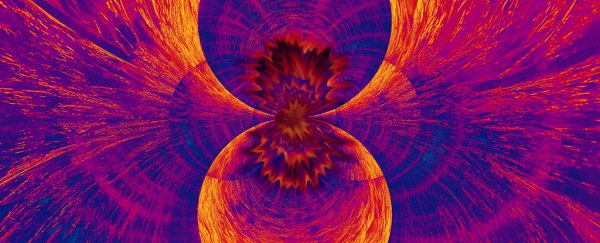A year after all but ruling out the possibility, a pair of theoretical physicists from Japan and the Netherlands have found quantum entanglement has something fundamentally in common with the physics that drives steam engines, dries your socks, and may even keep the arrow of time pointed in one direction.
This universal property, if indeed it exists as they suggest, would govern all transformations between entangled systems and give physicists a way to measure and compare entanglement beyond counting qubits – and know their limits of manipulating entangled pairs.
Quantum entanglement, the tendency for the quantum fuzziness of different objects to mathematically merge, is a fundamental part of quantum computing along with superposition. When particles, atoms, or molecules are entangled, knowing something about one tells us something of the other.
In their quest to realize those computing dreams, physicists have primarily been concerned with how to wrangle two particles into an entangled state and not disturb them, so they don't crumble apart and can reliably transmit information across great distances.
Less thought has been given, however, to whether entangled particles can be transformed from one quantum state into another, how difficult that would be, how many possible arrangements exist, and if, ultimately, the process of entanglement is reversible.
In thermodynamics, reversibility describes ideal processes that can be undone in a way that leaves the system – and the Universe – effectively unchanged. For example, turning water into steam with heat can drive a piston, while a piston pushing onto steam can return it to a heated liquid state.
If entangled states can also be undone, even in theory, it could mean other similarities with thermodynamics could point to a deeper truth in quantum mechanics.
"Our work serves as the very first evidence that reversibility is an achievable phenomenon in entanglement theory," says quantum physicist Bartosz Regula, from the RIKEN Center for Quantum Computing in Japan, who teamed up with Ludovico Lami of the University of Amsterdam on the study.
"This not only has immediate and direct applications in the foundations of quantum theory, but it will also help with understanding the ultimate limitations on our ability to efficiently manipulate entanglement in practice," Regula adds.
Reversible processes can't happen in reality, thanks to the second law of thermodynamics. Summarized in a concept known as entropy, it dictates that any new state in a closed system will likely not have the energy required to completely reverse after a change.
Want to reverse that piston? You'll need to pull energy in from somewhere else. Since the Universe is a closed system and can't get energy from elsewhere, its entropy will forever increase.
Given the strong relationship between entropy and reversibility in thermodynamics, identifying a parallel in entanglement could have profound implications for understanding quantum transformations.
To establish an 'entropy' of entanglement, Regula and Lami had to show that entanglement transformations can indeed be made reversible, just like work and heat can be converted in thermodynamics.
The suggestion that there is some kind of 'entropy' of entanglement is a sudden about-turn from Regula and Lami, who last year published a study in Nature Physics that claimed there was 'no second law of entanglement manipulation after all'.
The pair concluded that because entangling particles would always result in some loss of this entanglement, which could never be fully recovered, it would be impossible to transform one quantum state, or resource, into another and back again.
"We can conclude that no single quantity, such as the entanglement entropy, can tell us everything there is to know about the allowed transformations of entangled physical systems," Lami said at the time.
But those findings didn't deter them. Rather, they thought it suggested that a unified theory of entanglement, if one existed, was far more complex than the classical laws of thermodynamics. So they kept number-crunching.
Their latest offering, using probabilistic entanglement transformations, which only work some of the time but provide more power, shows that a reversible framework for entanglement might be possible.
But Regula admits that demonstrating how transformations of entangled particles might work in practice, not just showing it is statistically possible, involves tackling mathematical problems "that have evaded all attempts at solving them thus far."
What's more, the pair's work is a departure from previous attempts to characterize certain quantum transformations, because it only considers transformations that could be achieved with some probability – however vanishingly small those odds may be. As a result, these probabilities may not be enough to demonstrate the existence of repeatable, reversible transformations of entangled states in practice.
"Understanding the precise requirements for reversibility to hold thus remains a fascinating open problem," Regula says.
The study has been published in Nature Communications.
